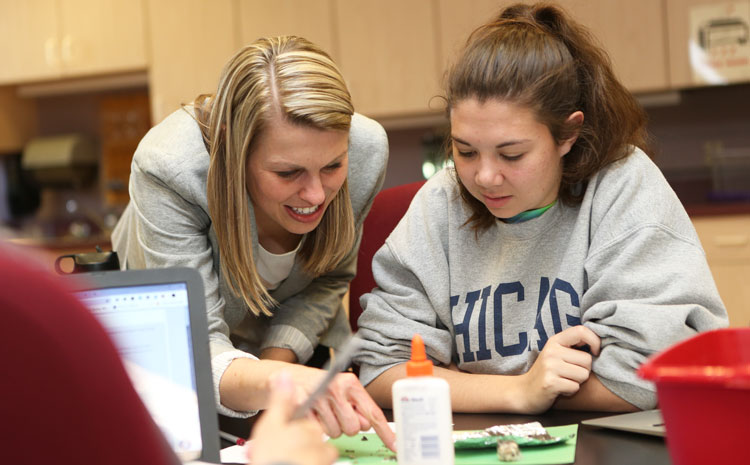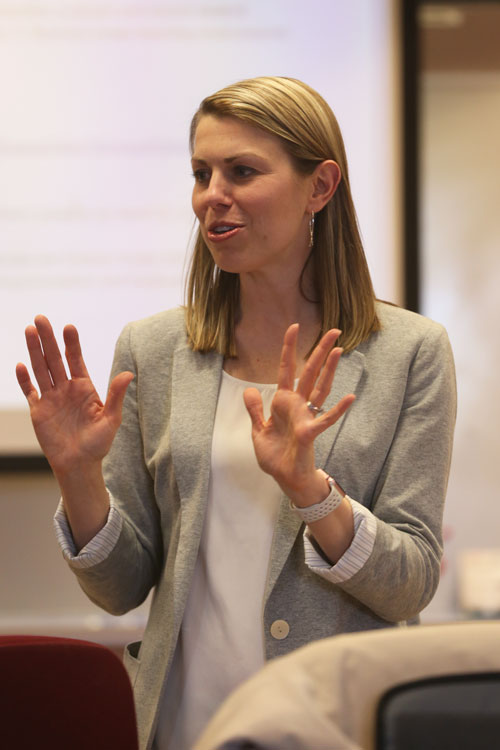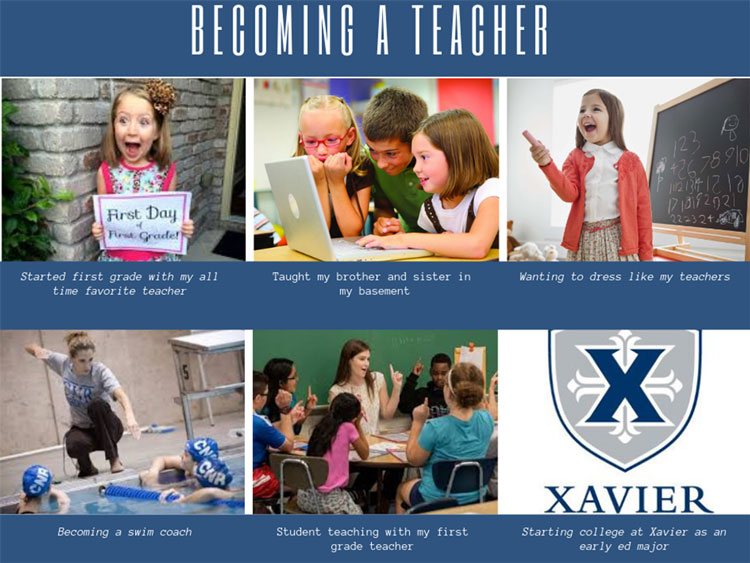
Faculty Spotlight: Lauren Angelone
Aug 8, 2019
Teaching Technology in the Classroom
On the second page of the syllabus for her Instructional Technology course, Lauren Angelone, PhD, includes the sentence: “There is no required textbook for this course.”
It’s an understatement, to say the least, that illustrates the distance elementary education has come from the days of books, paper, pencils, chalk and blackboards. For Angelone, an assistant professor in the School of Education since 2017, such old-style tools are still relevant today, but the issue has become: “How to use technology to enhance the student experience.”
“I always think about how to teach children,” she says. “It’s about learning with technology, not just using technology for technology’s sake.”

And so, Angelone’s undergraduate and graduate students, who are preparing to become early and middle childhood education teachers, take her Instructional Technology class to learn how to incorporate technology into their elementary classroom lesson plans. It's one of three different education courses she teaches each year—and the only one focused entirely on technology as a vital teaching tool.
Students in her class study a wide range of technology-related areas—websites and software programs, apps and video creation. They are surprised to be required to set up professional Twitter accounts so they can learn how to share best practices with other teachers. They create their own blogs and videos, and they learn about the ever-changing landscape of websites that offer digital programs to teach math, science, reading and everything else—and even 3D printing.
“Twitter has become a professional development platform for teachers,” Angelone says. “Twitter is a way to share what you do in the classroom and to learn from other teachers across the country and the world.”
But with increased access to technology comes responsibility, she says. “I spend a lot of time teaching my students to be critical users of technology with their students. I have them think about what technology is appropriate for the age of the student and subject area of students —for 1st graders to learn reading or for 5th graders to learn math skills. What technology really supports both content learning and the developmental needs of the students?”
But Angelone’s class is also fun. Her students get a lot of hands-on practice with the technical resources they study. One of her favorites is the “Bee-Bot.” In her compact office in Hailstones Hall, she pulls a bright yellow and black striped large plastic bee off a shelf and demonstrates how the toy can be programmed where to go, where to turn and when to stop.
By pressing the appropriate buttons on top of the bee the appropriate number of times, she instructs its progress on her office floor. It buzzes forward, stops and beeps, moves forward again, stops and beeps, turns right, stops and beeps. It’s charming, but it requires a human to program its progress. In other words—teachers are learning how to teach children the rudimentary rules of coding.
Beyond Bee-Bot, Angelone broadens her students’ exposure to more complex kinds of technology and digital platforms that work at every grade level.
Programs like Scratch teach young children computational thinking by programming stories, games and animation. Nearpod offers teachers the ability to make presentations interactive and personalized. Classcraft provides class management tools and a gamification element for students. PenPal Schools connects students worldwide to work collaboratively on shared projects. Minecraft: Education Edition mimics the popular game program to allow students to design content-related projects, like replicas of castles or bridges. Raz-Kids is an adaptive reading website, while Kahoot! is a student-response quizzing and assessment tool.
There are many more, and always new ones being developed. Angelone’s goal is to expose her students to the best ways to select and use the kinds of programs that enhance their teaching. She also wants them to become familiar with technology, so they meet for several classes online, create a 3D object, and produce a digital story.
Just learning about digital story-telling involves a lot of technology. To tell their personal stories about becoming a teacher, her students begin by creating a storyboard, either on paper or on the Canva digital platform. They post it to an online discussion board where they can view each other’s storyboards. They create a video of their story using video platforms like iMovie or WeVideo, then present it to the entire class online on Zoom.

Student Taylor Hogan’s storyboard about her journey to become a teacher includes photos of herself as a child heading off to first grade, playing teacher with her siblings, dressing like her teachers, and student-teaching at Xavier. Student Clara Igou said the class showed her all the possibilities that technology can offer teachers.
“I now have teaching platforms and resources as an undergrad student that a lot of my counterparts in other colleges do not have,” Igou said. “Xavier’s education department prepares you for all aspects of being a compassionate and dynamic educator. I loved learning about how to set up websites to even using technology like Schoology to organize online lesson plans. Professor Angelone is amazing at keeping up to date with what is current and cares that we are learning about resources that will help us in the future.”
That's precisely what Angelone wants her students to gain from the course. “I want students to think about ways their students use technology and how it impacts them and the way it gives them voice to express themselves. I try to make sure teachers understand the use of technology. It’s how we engage with our culture, and if students don’t have skills to use it, then they are being left out of the conversation.”
Learn more about majoring in Early Childhood and Middle Childhood Education at Xavier.